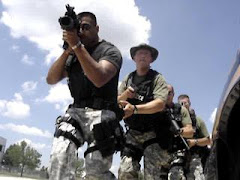Anyone who has been around tactical community for any
length of time, be it as an operator, trainer, and/or leader, is likely
familiar with the Viking Tactics (VTAC) 1-5 Drill. Sergeant Major (ret) Kyle Lamb, US Army
Special Operations combat veteran, author of “Green Eyes & Black Rifles:
The Warrior’s Guide to the Combat Carbine”, and president and founder of Viking
Tactics breaks down the essentials of the VTAC 1-5 drill in this video.
In this article, I will refer to this version of the VTAC 1-5 drill as the basic/base drill.
Industry innovators such as Travis Haley
underscore that there is a difference between rote drill training, and
understanding/developing drills at a “deeper level”. Travis Haley, US Marine Corps Force
Reconnaissance combat veteran, former CEO of Magpul Industries Corporation, and
president and founder of Haley Strategic Partners, LLC demonstrates an advanced application
of the VTAC 1-5 drill in this video.
The purpose of this article is to highlight that trainers/operators/practitioners
need to understand drill training at a deeper level in order to ensure a “best
fit” approach to training using the drills which facilitate optimal skill development within the
constraints of financial budgets and time. At the time of this article, I have
over 15 years of experience as a trainer in the tactical community. Although the core curriculum I use is CSAT based, I do use and teach the VTAC 1-5 Drill as one of
the training platforms for myself and my fellow students/operators.
·
No single drill will provide repetition of all
the various skills sets required in any given operational environment;
·
Some of the various skill sets needed for the
operational environment are trained in direct opposition to each other; and
· Optimal learning does not occur unless
trainers/operators/practitioners understand the inherent assumptions contained
within a drill’s practice method.
To illustrate these points, let’s again use the base VTAC 1-5
Drill as an example. In the first video, we see the drill executed (15 rounds total on 3
targets) in under 3 seconds. Training the
drill using this method allows practice of many critical technical & tactical skills to
include: optimizing the manner in which the weapon is “welded” to the body,
optimizing the manner in which the shooter traverses from target to target,
& optimizing the manipulation of the trigger. However, in order to optimize the cadence of
the drill, shooters maintain their finger-to-trigger contact while traversing
target to target. When the actions
needed to perform the drill at the cadence demonstrated are extrapolated into
the application environment, an operator moving a weapon from one threat to
another with his/her finger on the trigger (potentially across
innocent/friendly persons) would be violating most tactical SOP’s. What SOP’s you ask? Most shooters who learn
the “4 Firearm Safety Rules” learn that their finger is to be “off the trigger
until their muzzle is on the target”; cases such as Medina v. City of Chicago
show that our legal system considers the placement of the finger on the trigger
when not shooting to be “willful and wanton” conduct. And since we perform in the manner that we
practice, practicing with our finger on the trigger will increase the likelihood
that we will perform that way in the operational environment.
Does that mean that we should drop this version of the
VTAC 1-5 drill from our training curriculum? Absolutely not! It simply means
that trainers/operators/practitioners should understand that when they practice
the drill in this manner, they are training the optimization of aspects such as
weapon “weld”, traversing from target to target, manipulation of the trigger,
etc.
It is incumbent upon trainers and leaders to develop
utility in their training drills that are consistent with their application
environments. These “higher utility/application
oriented” drill variants should be added into the curriculum.
The variants should include the physical skills performance expectations
that we seek during application: for instance, if we expect the shooter’s finger
to be out of the trigger during movement from one target to the next, we have
to incorporate that into the drill’s “language/expectations”. If we expect a follow through sight picture
on targets that have been engaged, we likewise have to set that into the drill’s
“language/expectations”.
In this final video, we look at a "utility/application
oriented" variation of the VTAC 1-5 drill.
In this version, some of the individual skills being trained include
finger off the trigger while traversing from target to target, follow through
sight picture prior to traversing from target to target, and a speed load
during the drill execution (intentionally set up by using a partially filled
magazine). Since we wanted to
incorporate the rifle reload skill, we set the drill distance up along the
method described in the previous video by Travis Haley. This is because of the tactical preference to reload the rifle
at longer distances while tending to transition to the pistol at closer
distances. Even under 10 seconds total
time, the trigger manipulation in the drill is less than optimal when compared to the base drill. So while this variation builds utility, for a shooter to improve trigger manipulation skills, the original VTAC
1-5 drill should be used. So here we see two inherent opposite methods needed to train two necessary skills for the operational environment: optimal trigger manipulation when engaging and finger off the trigger when traversing, as examples.
Read more about building utility.














